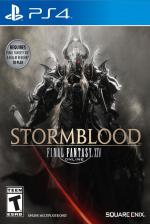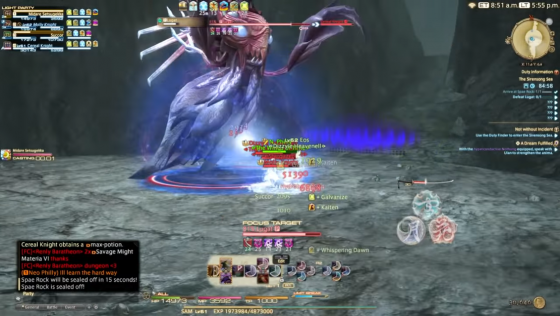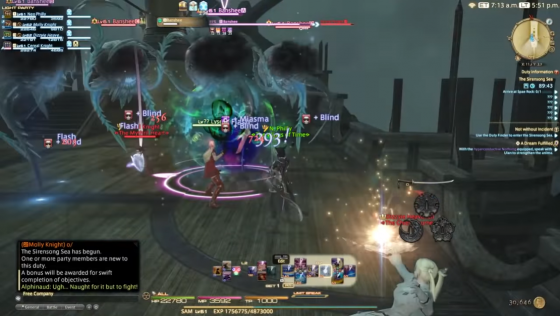The unique way Final Fantasy XIV forces players to play leads to interesting pay-offs with every expansion.
Part 1
Many hours into Final Fantasy XIV: Stormblood, your character, the Warrior of Light, steps off a boat onto the pier of Kugane. This medieval Japanese-style city is the only port on the island of Hingashi, allowing citizens from around the world to come and trade. It is a city of merchants, of power struggles behind the scenes. Kugane is every bit an ornate masterpiece and it's definitely the primary hook of Stormblood.
Most massively multiplayer online (MMO) games would offer an action-heavy quest with some cinematics and then thrust you into Kugane. That's what expansions do: they show off the highlights immediately, so they can get players hooked. There's always this fear that you're going to lose the player if you don't always hit them with the bright and shiny.
Final Fantasy XIV (FFXIV) is different. Though I have issues with the requirement that players have to get through all of the previous story content to play the latest stuff, it results in a different playerbase. FFXIV players are invested in the story of the Warrior of Light and the Scions of the Seventh Dawn. They care about the war between the Garlean Empire and Eorzean Alliance. They care about characters like Thancred, Urianger, Alphinaud, Raubahn, and Hildibrand. If they didn't, FFXIV would be something of a long slog of a game.
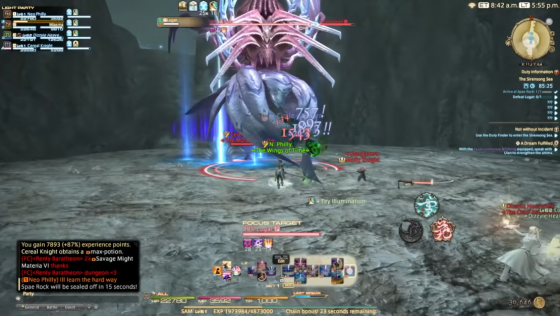
Since Square Enix knows their audience cares about the game's plot, to the point that many laud the game as the best Final Fantasy title in a long time, they can tackle Stormblood differently than many other MMOs.
Having this rapt (or captive?) audience allows the team at Square Enix to have some breathing room in how they approach expansions. Instead of sending you directly to Kugane and the far off lands of Hingashi and Doma, Stormblood drops the Warrior of Light into the region of Gyr Abania, where the occupied Ala Mhigo lies. In your ongoing fight against the Garlean Empire, this is your next step, fomenting rebellion in the displaced people of the region.
It's a slow burn, with early quests barely involving combat, just ferrying you from place to place, teaching you about the people of the region. "This is Rhalgar's Reach," the game says to players, and then it explains why the place is important. You meet the people who live there and understand how their lives have been ruined, not just by the Garleans, but also The Griffin, a local resistance fighter.
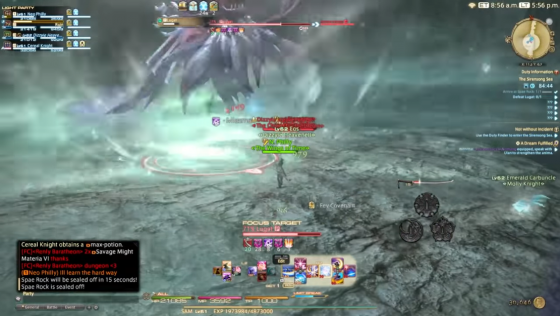
In fact, if you're new to Final Fantasy XIV and reach the Stormblood expansion through the use of jump potions, then you might be surprised at the lack of fighting in the main story quests overall. There are some "Kill X to get Y" quests, but many of those are optional quests for local NPCs.
I'll diverge here and say I always find it funny how the player character is part-errand boy, part-messenger, and part-godkiller. You are the Warrior of Light, Slayer of Gods, Rider of Dragons, Savior of Ishgard, but you are also the person random folks will ask to help them with all manner of mundane tasks. It'd be like if you saw Lebron James, Oprah Winfrey, Elon Musk, Queen Elizabeth on the street and said, "Hail, person, do you think you could go to the store and buy me some milk?"
FFXIV calls this out directly in some dialog, noting that helping folks with simple problems is how you continue to prove your worth. I'd argue killing multiple manifestations of elemental forces seeking to destroy the world has probably proven my worth, but that's neither here nor there. Perhaps I'm too above-it-all, but I think having killed the Elder Primal exempts me from finding your missing sacks.

Most of that is incidental though. Stormblood wants you to understand the plight of the Ala Mhigan Resistance before everything falls apart. When you step into Rhalgar's Reach a few hours after helping these people and the story introduces its villain, it matters. It's not enough to show a bad thing happening, to make a player or viewer feel, you have to anchor them emotionally within what's happening. Final Fantasy XIV trusts its audience to wade through the talking, the meetings, and the average lives of its people to get to the big moments. It's about pacing, instead of a breakneck rush towards the biggest, shiniest thing.
When you step off the dock into Kugane a few hours into the expansion, you feel like you've made it. Stormblood, and Final Fantasy XIV, feels like an actual journey. It's you the Adventurer and your squad - Lyse, Alphinaud, Alisaie, and Tataru - striking out into a new lands to make change in the world. You've spent 100+ hours in the lands of Eorzea and your adventure is now taking you to the far off lands of Othard. It's a transition, but also a reward.
Sure, there's fetch quests, kill quests, dungeons, and raids, but what makes Final Fantasy XIV beloved by its players is that story. This grand tale of the Warriors of Light and Warriors of Darkness. Of the Eorzea Alliance, the Garlean Empire, the Scions of the Seventh Dawn, and the Crystal Braves. Of all the characters you meet, whether in glorious combat, or in a quiet dinner.
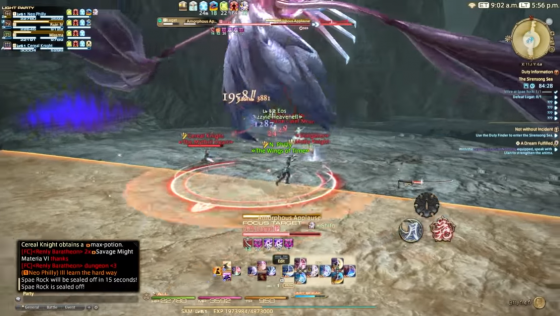
Final Fantasy XIV stands out because it has a story to tell and it trusts the player to take part in that story.
Part 2
Am I done with Final Fantasy XIV: Stormblood yet? No. I'm definitely within spitting distance of the title bout, where all the complex machinations and mundane tasks are paid off in a grand battle to end all battles. (At least in Doma.) I have fought more gods, I have helped a man learn his true place in the fishing world, and I have convinced a deposed prince to take up the fight for his people. I've walked and swam across the Ruby Sea, traveled to Yanxia and the Azim Steppe, all in the name of revolution.
Stormblood marks itself as a bit more assured over Heavensward, which itself was an improvement over A Realm Reborn. While Heavensward involved people, it eventually became concerned with gods, monsters, and forces of nature, focusing on Nidhogg and later the Warriors of Darkness. In contrast, Stormblood is all about the people. It's a tale of oppression and revolution, with your journey carrying you across a series of broken people eventually rising up and saying, "No more."
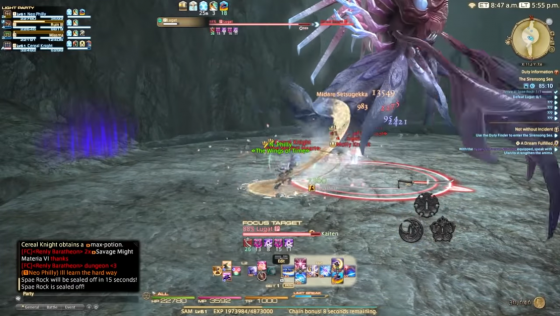
The core of that tale is Lyse, an exiled Ala Mhigan who wants to return to free her home from Garlean oppression. Things don't go quite as well as planned and instead of going backwards, Lyse and the rest of your crew move forward, taking the fight to Doma. She is stubborn and upbeat, without being entirely foolhardy. Over the course of Stormblood, you see her growth from more of a side character into the expansion's nominal lead. Joined by Lyse are characters like Gosetsu, Yugiri, and Hien, supporting characters who retain a personal stake in Doman liberation. They all represent groups of people who are lost, even as they themselves retain a sense of hope. (Who wouldn't hope when they have me on their side? Did I mention I've killed gods?)
What's surprising is despite the subject matter, Stormblood is not a dour adventure. It's damned upbeat. Your compatriots are fun people. In-between the solo grind of the non-story quests, you start to look forward to seeing them. When people say that Final Fantasy XIV feels like one of the "main" Final Fantasy games, it's the interactions with your supporting cast and the villains that they're talk about. I'm happy to see Alisaie, Lyse, Tataru, Gosetsu, or Yugiri in cutscenes and quests. I legitimately want antagonists like Yotsuyu and Grynewaht to die. And Zenos is such a delicious villain that I kind of like him.
If the main story and the quests are where Stormblood shines, they only serve to make the non-story quests pale in comparison. The localization team at Square Enix does its best cover these quests with fun references and some interesting dialogue, but as far in as I am, I have to admit they come across as a slog. Go here, click this, kill that, return to quest giver. They just feel so rote and for some reason, more so than some other MMOs I've been playing like Elder Scrolls Online. Some rise above - like one quest where you use pictures to find specific locations - but for most, you just grit your teeth and trudge on. I almost wish some of the quests were simply regional: enter an area and you automatically get the "Kill X" or "Bring Y loot to a villager" quests without the preamble.
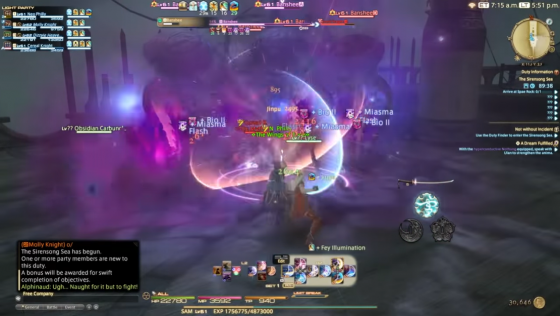
It's all good because the dungeons, Primals, and solo duties are where Stormblood makes up that grind. Square Enix has these down to a science, with interesting things to do, or in the case of some of the more straightforward dungeons, a cool look to the entire thing. Susano has one party member defending against a giant sword, Shisui has you fighting in an estate in an underwater dome, Bardam's Mettle has one fight where you're just dodging AOE patterns, and the corridors of Castrum Abania are full of Magitek and mutants. You can tell the team is stretching their muscles and having fun in these encounters.
Swimming was one of the hooks of Stormblood, but honestly it doesn't directly add much to the game at this point. It allows Square Enix to have some more interesting level layouts, like the rebellion hideout in Yanxia being behind a lake bottom or the deep trench leading to the Shisui of the Violet Tides dungeon, but there's little you can do underwater. There's no combat and the addition comes across as another traversal method, like flying but with less impact. World Of Warcraft did the concept a bit better with Vashj'ir in Cataclysm and some Suramar world quests in Legion. I expect now that it's in the game though, the development team will be able to play around with the idea more in further patches and expansions.
I did take a break from the revolution to try out the new Stormblood jobs and see how the new job gauges work for folks who aren't Paladins. There's one gauge per job, and each gauge is meant to reinforce the basic idea of that job: do the thing you're supposed to do and you're rewarded with more powerful offensive and defensive moves. On Paladin, the Oath Gauge fills in as you block in Shield Oath or attack in Sword Oath, allowing you to use moves like Sheltron and Intervention to protect yourself or your party. It's rather straightforward, though I think the Shield Oath version needs a bit of tweaking.
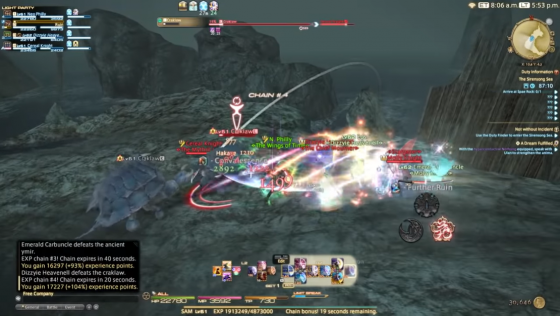
Of the Stormblood jobs, The Red Mage is a stylish dancer, both in concept and execution. Red Mages use White and Black magic to attack from afar. Each white or black spell causes its side of the gauge to fill up and players are suppose to balance both sides to keep themselves "Red". That gauge can then be spent on improved melee attacks with a classy rapier; Red Mages have a dash and a backflip that move them in and out of melee range. It's all about balancing white and black, range and melee; dancing between two states to maximize damage.
The Samurai is my favorite of the two though. The Samurai has a few set combos, each generating their own type of Sen. You can then spend that Sen on different abilities, like the AOE Tenkagoken or the high-damage single-target attack Midare Setsugekka. On top of that, at 62 you unlock the the Kenki gauge which fills by using most Samurai weapon skills and can be used on Hissatsuken attacks.
It's pretty simple, but what draws me in with the Samurai are the visuals of the attacks. Based heavily around the artistic style of Setsugekka, every attack with a Samurai is just... pretty. You'll trace moons in the air, disperse foes in a shower of cherry blossoms, or slash with cold precision in a trail of ice. Samurai has a unique aesthetic that's not really covered by any other job in the game and that makes it a standout for me.
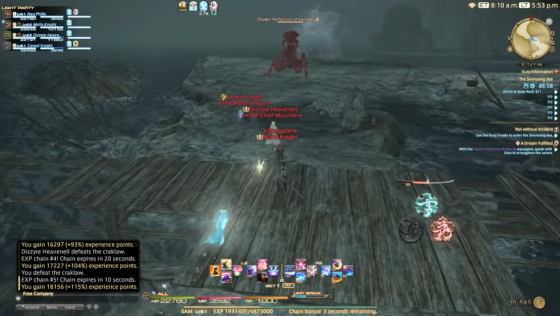
Regardless, I'm on the final road for Stormblood. This week should mark the end of my journey for the time being, finishing up the main story quest and tackling the EX versions of both Primals. Check back then, when I'll give the game my final score.
Final Verdict
The revolution is over, but the journey has just begun. I admit, I was surprised after a focus on Doma and the surrounding regions to find my adventure returning me back to where I started. It seems apt, a circle closing out a journey that sent me far from what my character would call home.
The final third of my playtime carried forward the same highs and lows of the rest. When Final Fantasy XIV is on point, it's a rousing tale of endless hope and throwing off the yoke of oppression. It's interesting dungeon and Trial encounters, with some kickass bosses and thematic hooks. When Stormblood is faltering, it's in quests that feel like a struggle, moving back-and-forth between the same few locations or simply killing X. Those are small issues for an expansion that simply works though.
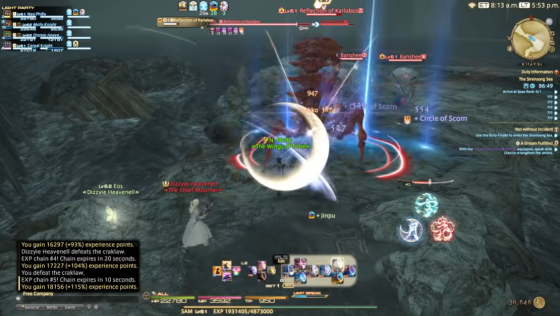
Are there things Square Enix could've done better? Sure. A few more interesting quest designs to go with the excellent writing on the non-story missions. Perhaps either a Tank or Healer job to join the excellent Samurai and Red Mage. And it does feel like some of the other damage-dealing jobs got hit at the same time that the new shiny jobs hit the scene.
None of that matters in the wash though. When Zenos, who has become one of my favorite Final Fantasy villains, meets the final result of all his actions, you'll say "Goddamn." When the final boss of the main story towers overhead, you'll be measured and challenged in one of the hardest fights to date. When what was a supporting character steps into the role that she earned over the course of Stormblood's tale, you'll care. When she delivers the denouement, you'll say the entire thing - good and bad, great and small - was worth it. Because it was.
Stormblood is winner of an expansion. No one, back when Final Fantasy XIV released back in 2010, could have imagined the game would see such a turnaround. No one. It's a testament to the hard work of the team at Square Enix that not only has the turnaround happened, but Final Fantasy XIV is now one of the best MMOs currently in operation.

If you have the time and effort, play Final Fantasy XIV. Play Stormblood. It's worth it.
The Nitty Gritty
Sound
There are some amazing tracks in Stormblood. The song of The Lochs, Ruby Sea's underwater tune, the rousing epic of Azim Steppe. As someone who generally doesn't pay attention to game soundtracks, colour me impressed.
Visuals
Stormblood has a dodgy texture here and there, but damn, this game can look great when it wants to.
Verdict
Final Fantasy XIV just keeps getting better. Stormblood stands as an improvement over the great Heavensward, with a strong story grounded in people attempting to free themselves from oppression. There are some stumbles here, but when Stormblood is on, there's an excellent adventure, great characters, and some awesome enemy encounters. Stormblood is the ongoing foundation of something magical for MMO and Final Fantasy fans alike.


 30th June 2017
30th June 2017